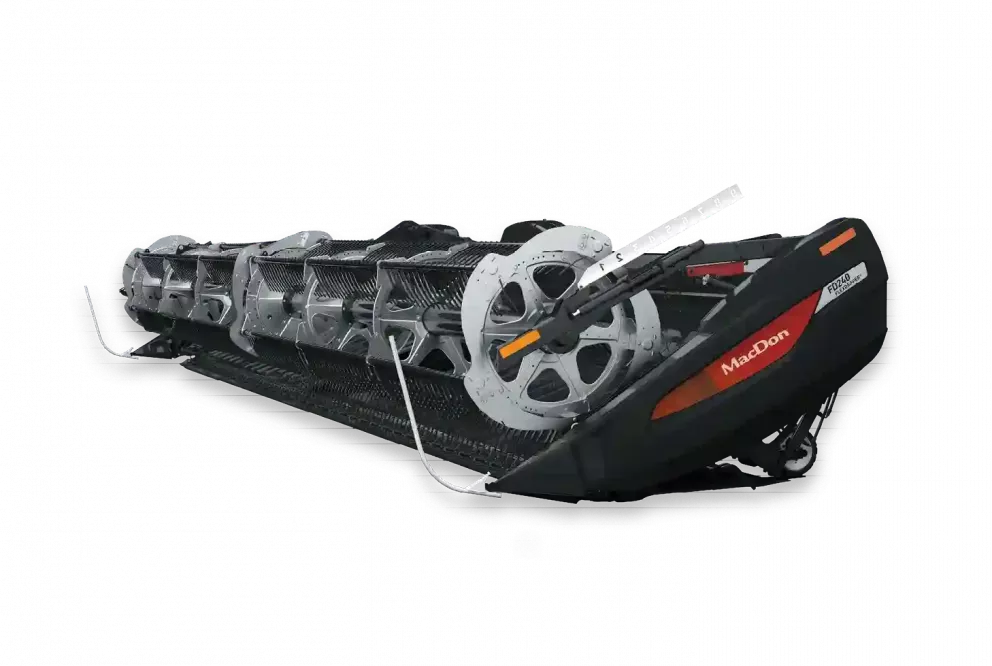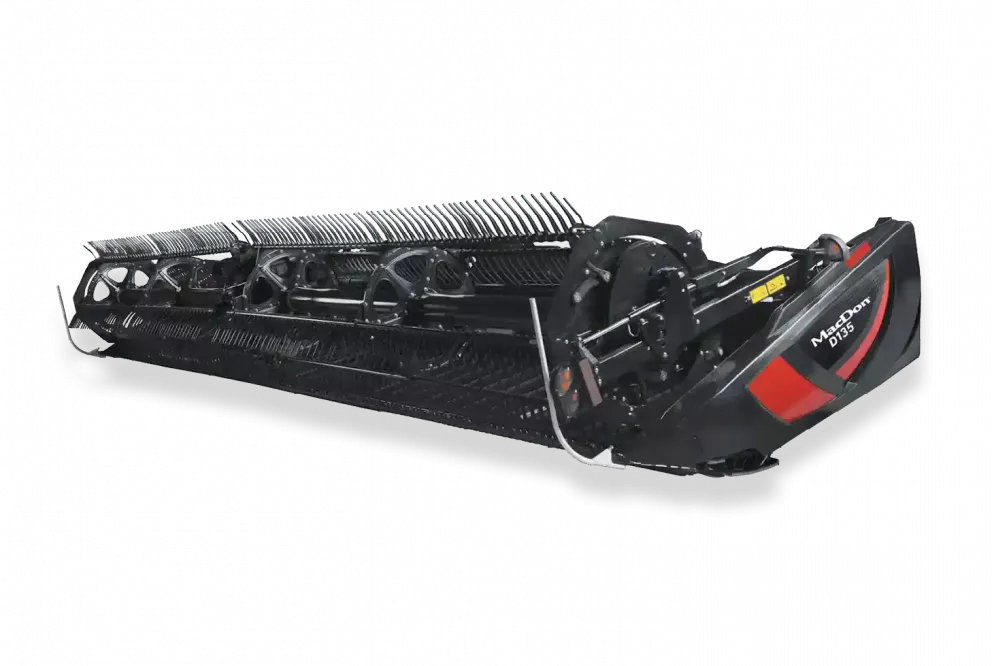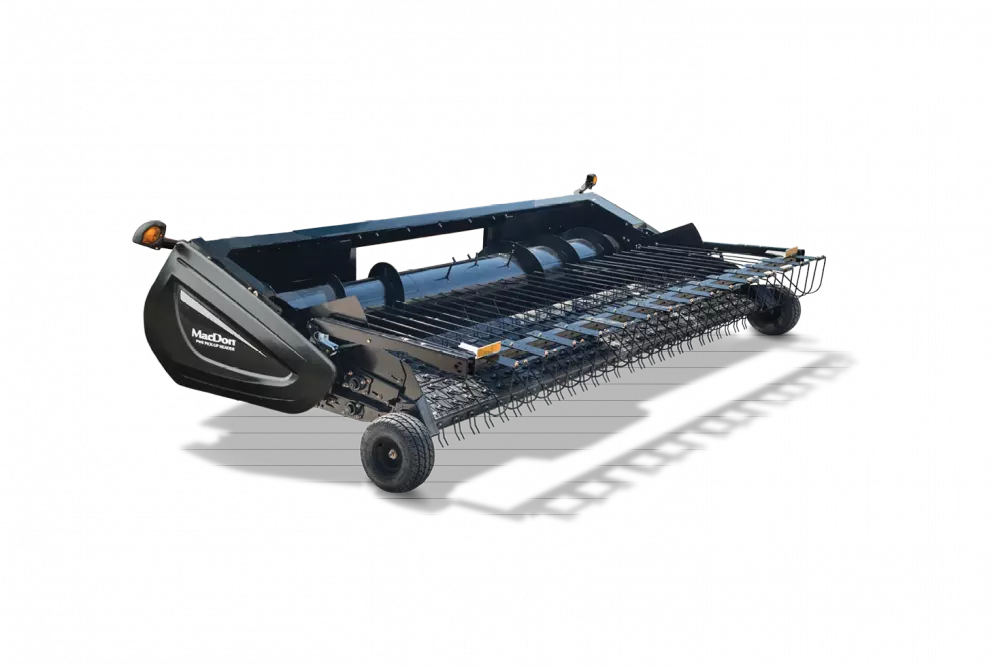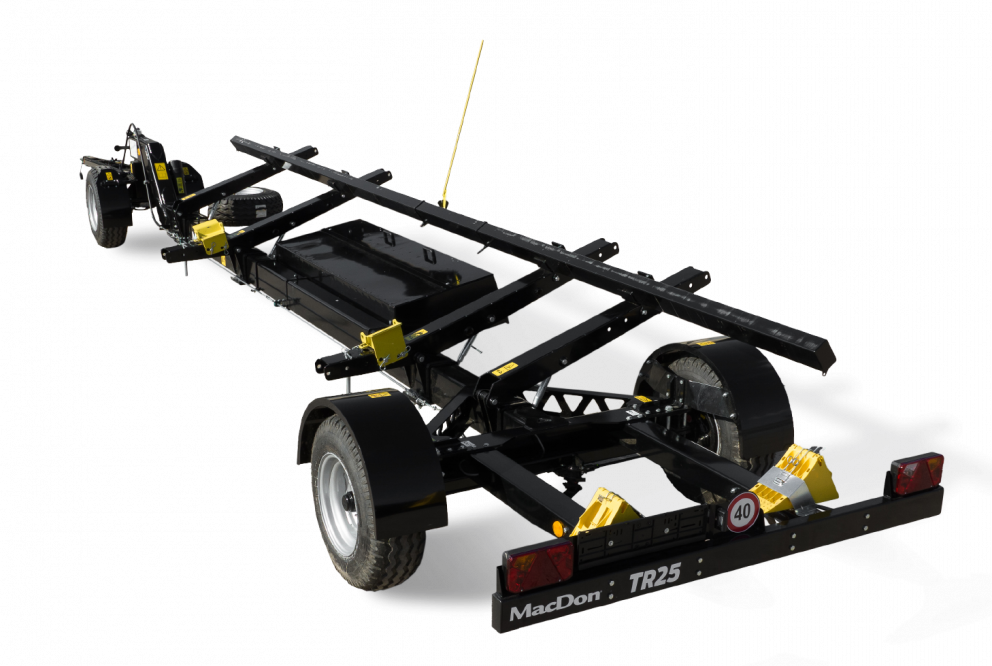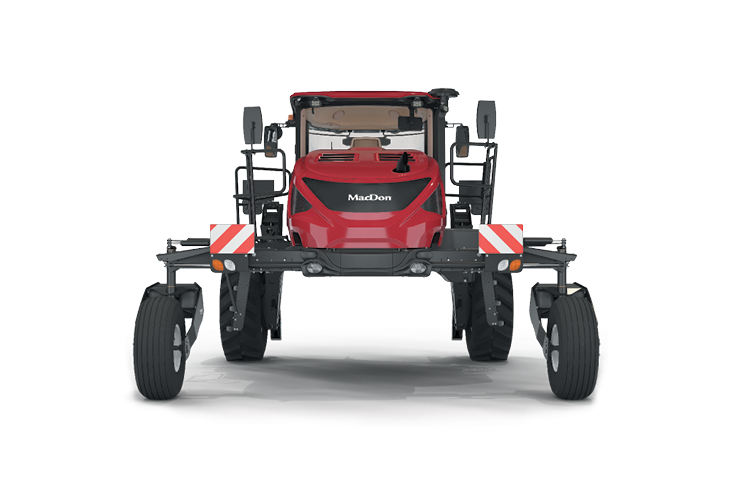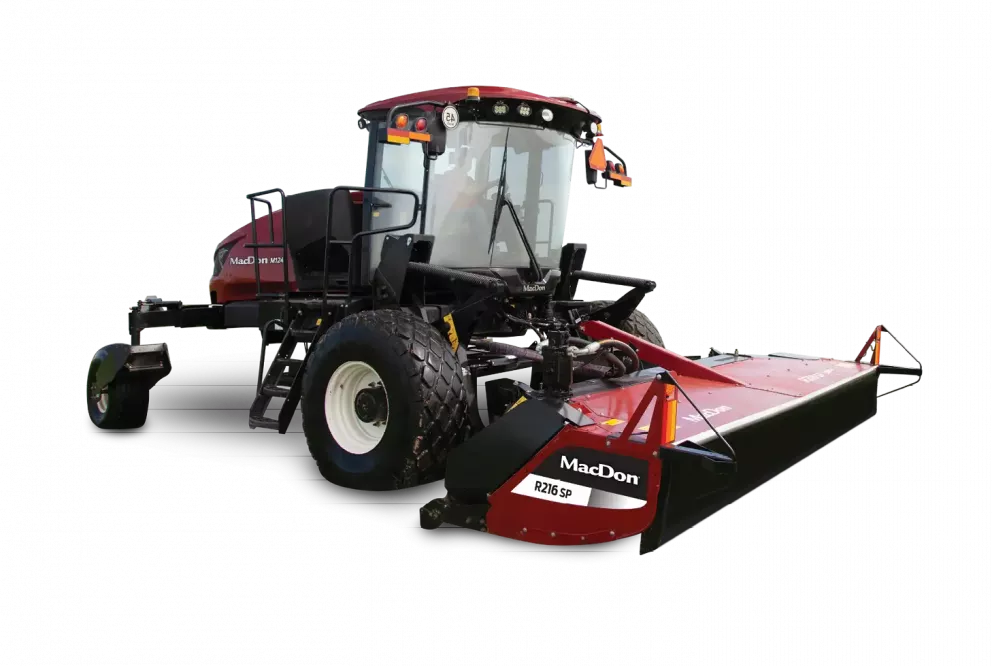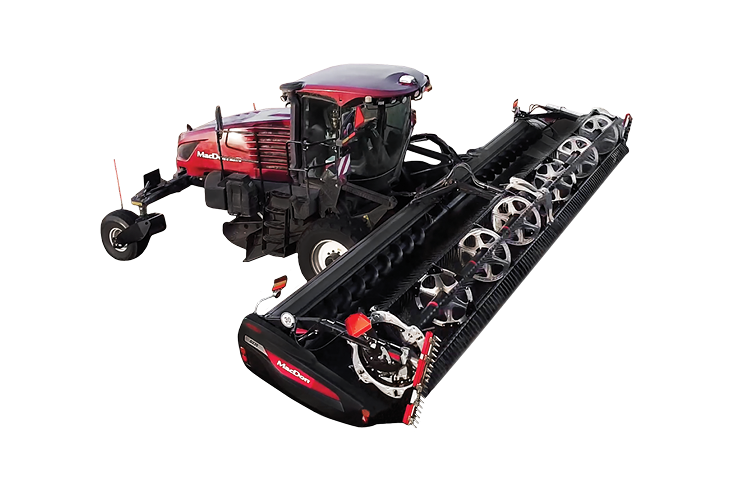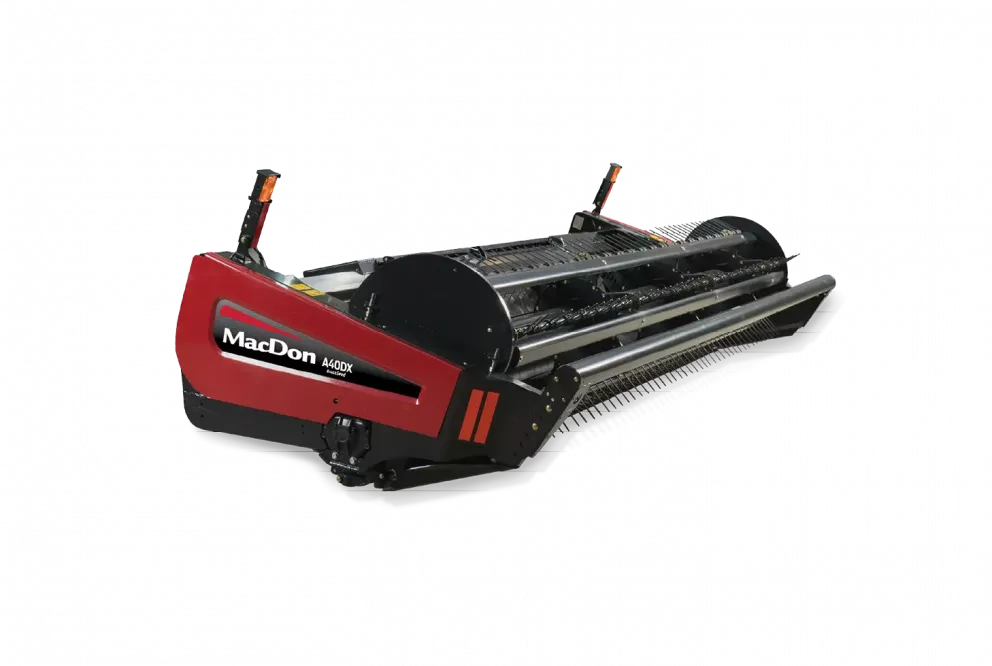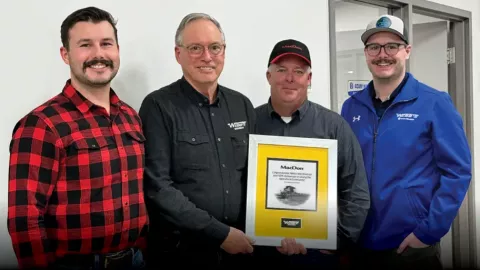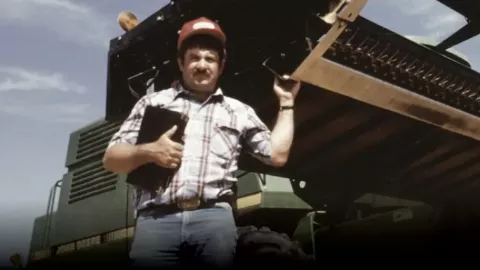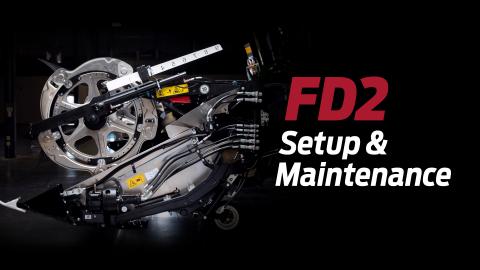Need For In-Field Speed!
Manuel Cabral of Costa View Farms has a lot of ground to cover; MacDon helps him do it, covering nearly 400 acres in a day.
Summers aren’t just hot, they shimmer in the fields around Madera in California's Central Valley. From June through September machine operators can look forward to average daily highs of 31oC (88oF), with afternoons in July and August the most grueling. Then a machine’s air conditioning is really put to the test when the mercury climbs to a sweltering 36oC (97oF) on average, and frequently well over that.
Now, most windrower operators faced with heat like that would likely prefer to start their days early to get ahead of the sun, but that’s not the case at Madera’s Costa View Farms, a large dairy with about 15,000 head of milking, support and dry stock to feed. Here they will wait until most of the morning’s cooler temperatures have dissipated to begin cutting their alfalfa.
“If you cut the alfalfa too early in the day, with the heavy dews that we get here, it tends to test lower quality,” says Manuel Cabral, Costa View’s Farm Manager. “We have learned over the years that a lot of the plant’s energy and nutrients are in that dew, so if we want to maximize nutritional quality, we have to wait for the dew to be completely off and the plant to shut down fully to cut. Unfortunately, that’s usually not until around 11:00 am, which gives us a much shorter window to cut than most other dairies around here.”
Of course, reducing your harvest day by almost half makes having a fast windrower - both in the field, and between fields - that much more important, and why Cabral says they choose to run MacDon windrowers over anything else.
“I’ve used other brands in the past, but MacDon windrowers do seem to outrun other machines. In fact, we tested it ourselves when we bought our two new MacDon’s last April by demoing another brand against them for a day. MacDon definitely covered a lot more ground and pretty much knocked it out of the park compared to the other machine. I think you can cut at least 15% more in a day with MacDon compared to other brands.”
Prior to buying two MacDon M1240 Windrowers mounted with R216 Disc headers in 2021, Costa View had been running a couple of MacDon M205s with R1 Disc Headers.
“We ran our previous MacDon’s for about six years and had put a lot of acres on them. We ran them hard and I actually think we probably could have traded them in a little earlier.”
Running their machines hard is an understatement given how much Costa View’s windrowers are asked to cut. In total they cultivate 1,400 acres of alfalfa year round, supplemented by another 3,400 acres (1375 hectares) of winter forage (wheat, oats and ryegrass) all of which is doubled cropped with corn or sudan. They cut everything with just their two windrowers, and they even do some custom cutting on the side.
“We harvest our hay every 26 days, rotated through 14 different fields. That means we’re cutting hay almost every other day throughout the year. Last year alone we put a little over 12,000 acres (4856 Hectares) on each of these new machines. When these machines start moving, they move.”
Cabral says that his two operators, one who is his brother, give their new MacDon’s top marks for their improved road speed (up to 45 km/h/28 mph).
“The furthest we have to travel to one of our fields is about 10 miles (16 km), but we will travel further when we’re custom cutting for another dairy. It helps us a lot that we can travel from one side of the county to the other in just an hour or so.”
His operators have also remarked on how much better the new windrowers handle at speed on the highway thanks to the addition of MacDon’s patented CrossFlexTM Suspension.
“We’ve found that these new machines travel even better than the previous model. They’re more comfortable, easier to control, stop quicker and ride a lot smoother.”
But it is in the field cutting that Cabral and his operators have noticed the largest number of improvements with the new machines. Of course, the ability to move faster tops the list here as well.
“With these new windrowers, we are now able to cut at up to 18mph (30km/h), especially if we are cutting to chop because we’re just doubling the windrow into a pile (using MacDon’s optional Double Windrow Attachment), so consistency doesn’t matter as much. Before we could only cut at 12 mph (19 km/h), so being able to cut a lot faster means that we can harvest more than one field a day if we have to. I’ve been able to do nearly 400 acres (162 hectares) in a 10 hour day.”
“If we are harvesting to bale, however, we usually don’t go nearly as fast because we want to lay the windrow flat and smooth without any clumps so that it can dry out better.”
One feature that they really appreciate on their new windrowers is the ability to have preset configurations (cut height, tilt, and disc speed) for the R2 Disc Header, which can be deployed with the press of a button from the cab. Cabral says that is a big time saver for them as his operators no longer waste time fiddling with adjustments every time they get to a new field.
“We’ve had other machines here, I won’t mention the company name, but it’s like you’re playing a video game pushing all the buttons you need to get the machine set up to where you want for each field. With these new MacDon’s, however, the operator can just hit a button and go.”
“This new header also has sensors so that when you set the float at a certain percentage it automatically adjusts so it is always at that percentage. That kind of automation makes these machines very user friendly and easy to train on.”
The ability to finely adjust the header’s cut angle – from 0° to 8° below horizontal – has proven particularly helpful for Cabral and his operators.
“Having control like that is really important when we are first cutting alfalfa and the roots are really tender. If we scalp a little too low we will actually pull the roots out of the ground, but with these machines we can cut as delicately as we need to and not hurt the crop at all. Alternatively, when we get to our rougher fields we can adjust the float to cut as tough as we want.”
In their winter forages the header has also shone, especially with its ability to lay wide, uniform and thoroughly conditioned windrows.
“The header gives you the option of laying the windrow really wide, which is critical when we are harvesting our ryegrass in January and February. We tend to have a short window between storms at that time of year, perhaps as few as eight days, so being able to lay a wider swath really helps to quicken the dry down time and get that crop out before the next rain.”
Conversely, when they are harvesting their winter forages in the summer, the problem can be too rapid moisture loss in the crop, but here too the new machines have helped.
“The conditions we get here in the summer can make things extra challenging cutting our wheat, which can turn really quickly if it gets too hot. If that happens we will likely have multiple fields that need to be cut instantly or else they will become over dry to chop for silage. These MacDon machines have made it really easy to move extra fast to get to our fields and get them down quickly so that the chopper can pick them up.”
California’s summer heat isn’t just tough on their crops, it can also be punishing for their operators as well. But here Cabral says the M1 Series’ upgraded cab has performed superbly in keeping his operators comfortable.
“You can only imagine how hot it can get out there. Not only do you have the intense California sun but you also get the heat off of the machine; if your air conditioner isn’t very good it can get to 120oF (49oC) in the cab, and then you’re just dying. But this new deluxe cab has leather cooled seats and a better air conditioning system to keep you cool. Also, the roomier cab with its bigger roof provides more shade and helps reduce the glare of sunlight coming into the cab.”
So impressed has Cabral been with his new MacDon windrowers that he had no hesitation recommending them to a neighbor, who decided to buy one himself after coming over to watch them run.
“I would estimate that about 75% of the dairies around here are using MacDon windrowers now, mostly because they save us a lot of time.”
